Anarea > Systems > MU > Mistletoe & Magic
3rd edition (2024): effective 21 I 2506
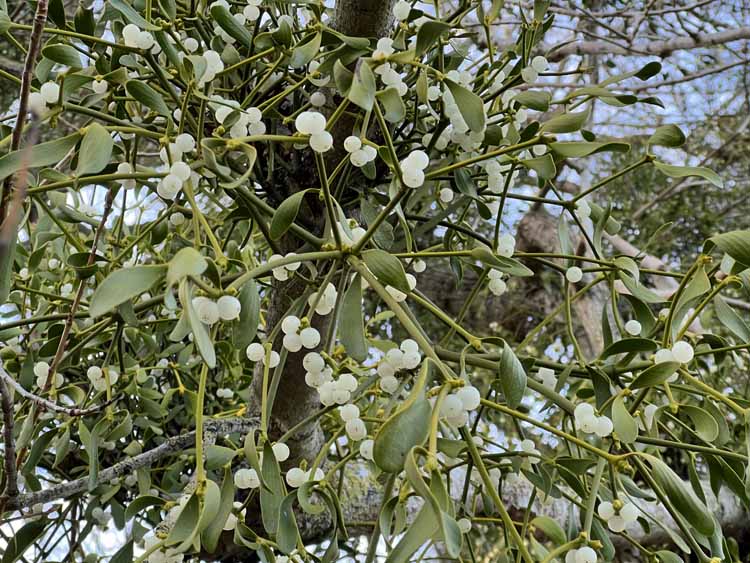
1.1 The Druid ("Dr") uses the Magic of Nature Spirits.
1.2 To do so they must first attune themself to Nature by appreciating ("Instressing") its Naturalness ("Inscape"). They then Cast a Druidic Spell of a particular Druidic Cycle, which they have previously Bound and learnt, using appropriate Media if they wish to increase its power. An appropriate Level of Nature Spirit then produces the Effect of the Spell, dependent on the Incantation, Power (in both Spell Points and Instress Points), Media, and a limited amount of discretion on its part.
1.3 The Magical Power of Nature, which is exercised by Nature Spirits in producing Druidic Spell Effects derives from a number of sources which have an influence on the Natural World, involving the various interactions between Animals, Vegetables, Higher Beings, the Elements and Dreams. Druidism is therefore a diverse discipline of Magic-Using, with many Cults having their own specialist Druidic Cycles of Spells.
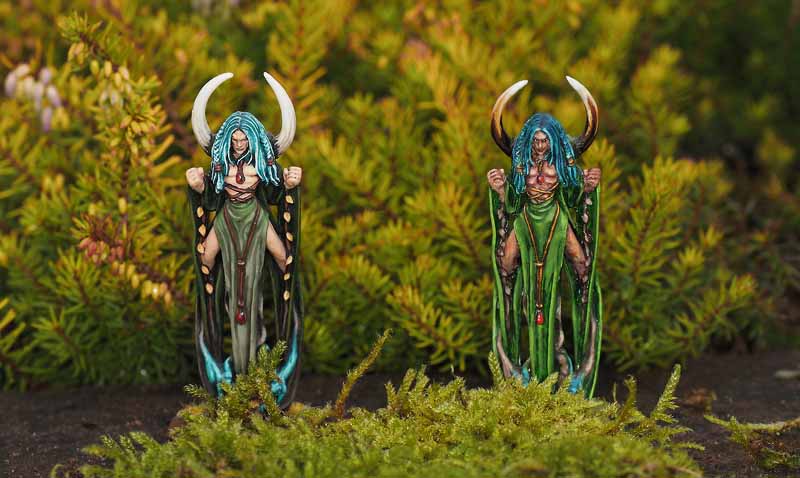
2.1.1 The Magical Power of Nature derives ultimately from KOROS, in His/Her Aspect of God of Life and Death and from the Gods of Nature, Who exercise the Power of Life and Death over Their respective Aspects of the Natural World. This Power is Delegated to the Nature Spirits, Who use it to perform the Yribt, Sered and Druid Cycles of Druidic Spells. The Yribt Cycles are concerned with all things Animal, the Sered Cycles with all things Vegetable and the Druid Cycle is the Generalist Cycle of Druidic Spells, concerned with the interaction of Nature with itself, the World, and Higher Beings.
| Kingdom | God | Aspect | Symbol | Druidic Cycles |
| Animal | JAPAL | Mammals |
 |
Yribt Cycles, Druid Cycle |
| Animal | VIXEW | Reptiles |
|
Yribt Cycles, Druid Cycle |
| Animal | YELLIP | Birds |
|
Yribt Cycles, Druid Cycle |
| Animal | LLYWELLA | Fishes |
|
Yribt Cycles, Druid Cycle |
| Animal | XAXIX | Insects |
 |
Yribt Cycles, Druid Cycle |
| Vegetable | NORRID | Trees |
 |
Sered Cycles, Druid Cycle |
| Vegetable | UMBOR | Plants |
 |
Sered Cycles, Druid Cycle |
| Animal | QUAYAG | Organisms |
 |
Yribt Cycles, Druid Cycle |
2.1.2 The Power of Life and Death is represented by the Cycle of Life:
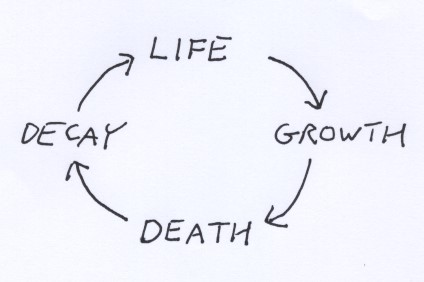
2.1.3 Note that Life and Death are opposite and equally important Forces, and likewise for Growth and Decay, with each leading to the others through the Cycle of Life. Life and Growth represent the Light Side of Nature, whilst Death and Decay represent the Dark Side of Nature, but both the Light and Dark Sides are needed to keep the Balance (as maintained by KOROS). The Light and Dark Side of Nature represent the influence of the Forces of Good and Evil upon the Natural World, and the Light Side tends to be favoured by Good and Neutral Druids whilst the Dark Side tends to be favoured by some Evil Druids (also known as "Anti-Druids").
2.2.1 The Nature Spirits work closely with Elementals in the day-to-day running of the Natural World, and so are able to call on Them to assist in performing the Ranian Cycles of Druidic Spells. The Elemental aspects of Druidic Spells are therefore ultimately derived from the Elemental Gods.
2.2.2 The Ranian Cycles involve Earth, Air, Fire, Water, Gravity, Planist and Illusionist Effects. Body and Mind Effects are within the Powers of the Nature Spririts Delegated to Them by the Gods of Nature, so fall within the Yribt and Sered Cycles to the extent they are Cast on Animals or Vegetables.
2.2.3 Although an especially observant Magic-User may spot an Elemental involved in the performance of a Ranian Cycle Spell Effect, the Spell is still carried out by the Nature Spirit - but where They cause an Effect that involves an Element They need to direct an Elemental to produce it.
2.3.1 The Animal and Tree Kingdoms of the Gods of Nature and Their charges are connected by the Dreamworlds of their shared consciousnesses, with most species having their own Dream Kingdom. But all are connected, with some species sharing the same Dream Kingdoms. These Dream Kingdoms have their Light and Dark Sides, of Daydreams of Life and Growth and Nightmares of Death and Decay.
2.3.2 The Natural Areas of the Overworld and Underworld are divided into Forests, maintained by the Nature Spirits, which are divided into Major Forests (with Sub-Forests) and Minor Forests.
2.3.3 The connections between the Forests and the Dream Kingdoms of Nature manifest as the Sacred Circles. These were originally created in the minds of the more powerful Dreamers of Nature, whether Druids, Ents, apex predators or trees, using the mental device of the Hall of Mirrors, with Twelve Gateways round a Central Sacred Heart. But the Druids of old built or grew physical Circles of Stones, Totems or Trees to focus their power and make it more easily accessible.
2.3.4 The Trance Cycles of Druidic Spells draw upon these Mysteries and in perfoming these Spells the Nature Spirits are exercising Powers delegated by MERLO, Demigod of Dreams through His subordinates the Dream Demons. The Trance Cycles are restricted to specialist Mystical and Shamanic Cults and to Seers.
2.4.1 The Anti-Druidic Spell Cycles represent the Dark Sides of the standard Druidic Spell Cycles, so:
2.4.2 Anti-Druidic sects of certain Druidic Cults may have Dark Side versions of those Cults' Druidic Spell Cycles: e.g. the Ecanrt Cycles of the Dark Forest or of the Dark Sands.
2.5.1 MIRIMI, Goddess of the Moon, has an influence upon the Growth and Decay of Plants, which manifests itself in the Bonuses that may be obtained on Druidic Spells from Druidic Media.
2.5.2 Various Druidic Beastmaster Cults worship Aspects of different Clerical or False Gods as powerful forms of their Totem Animals. For example many Light Side Overworld Wolf Cults worship THE GREAT WHITE WOLF (as an Aspect of ESCUS), whilst Dark Side Underworld Wolf Cults worship THE GREAT BLACK WOLF (as an Aspect of ALTIS). Such Gods grant Clerical Spells to the Clerics of Their Cults (through other Clerical Gods if They areFalse Gods). They may also appear to their shamanic worshippers in the Dreamworld of the Totem Animal.
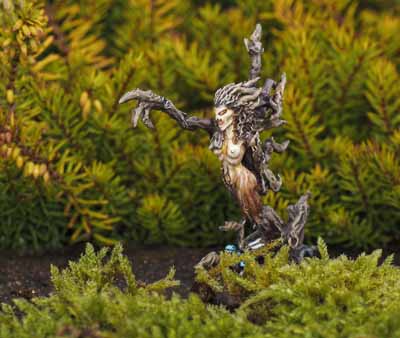
3.1 Like their fellow Spirits, the Elementals who carry out Elementalist Spells, Nature Spirits are concerned with the day-to-day running of the World. But there are several important differences between the two kinds of Spirits.
3.2 Nature Spirits are not subordinate to any particular Gods of Nature, but are free agents. However, They greatly respect the Gods of Nature, and are concerned to ensure the smooth and peaceful running of Nature in accordance with the wishes of the Gods of Nature. Their function is largely supervisory, as Nature grows and decays of its own accord in accordance with the Cycle of Life, but needs some protection and direction. Nature Spirits are simple, peaceful Beings, who live from day to day, exclusively in and for the present, but They are far from stupid.
3.3 Nature Spirits are almost always associated with a particular natural locale within Their home Forest, where a special charge or place is their home. If it is destroyed, They are likely to abandon the will to live, and so die (but may take retribution upon the destroyer first). Spirits are often classified by Their charges, with which They have a special affinity, though Their magical Powers are not limited to related Spells - all Nature Spirits being able to perform all Druidic Spells within the standard Cycles, subject to level constraints as shown in the table below. However, specific Types of Spirits do have additional Powers enabling Them to perform Druidic Spells within specific non-standard Druidic Cycles, as below.
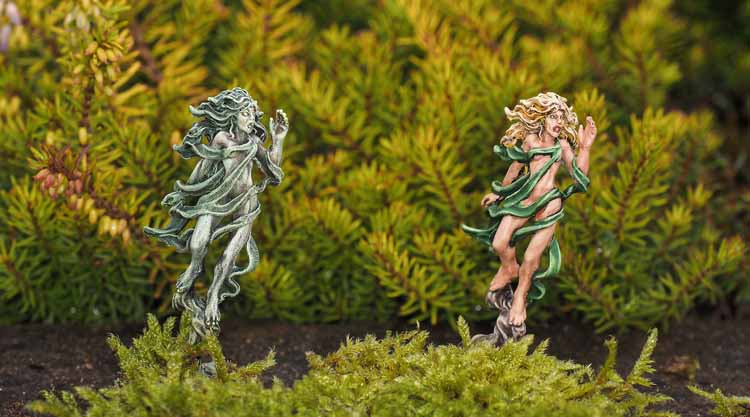
3.4 Nature Spirits may be of the Light or Dark Side. The Dark Side variants are usually prefixed by "Anti-"; e.g. an Anti-Dryad is a Dryad of the Dark Side, concerned with the Decay of Trees, Autumn, thorns and poison. If a Forest tips over into a Dark Forest, its Dryads will become Anti-Dryads.
3.5 Because many humans have largely lost touch with Nature, they think Nature Spirits shy and withdrawn. In fact the converse is true; it is humans who have withdrawn from Nature, and so are unable to converse with its Spirits. To those who know how to approach Them and show due appreciation of Nature (Elves and Druids in particular) They can be most friendly. Because of Their eagerness to help those who appreciate Nature, They do not have to be compelled to carry out Druidic Spell duties. They have simply been delegated Their Powers on condition that They will always do their best to ensure that Druidic Spells are carried out; a condition they are happy to fulfill.
3.6 Nature Spirits vary in Elemental Level from 1 to 10. A Spirit has the Powers to produce the effect of any Druidic Spell of any standard Spell Cycle and of any non-standard Spell Cycle relevant to Its type and charges (as shown above) of a Spell Level less than or equal to its Elemental Level. It does not cost the Spirit SP, instress or IST to produce Spells, because It is using Its own Magical Powers, rather than using the Magic of another. The Maximum Throw Spirits of a given Level can produce is as follows:
X = Spirit cannot produce Spells of that Level.
No.= Maximum Throw Spirit can produce on a Spell of that Level
Success Throw (in the left-most column) is the usual Throw required for a Spell of that Level to Succeed. For the actual Throw required for a particular Spell to Succeed, see its Spell Specification.
3.7 Druidic Spells or Nature Spirits of over 10th Level are not available.
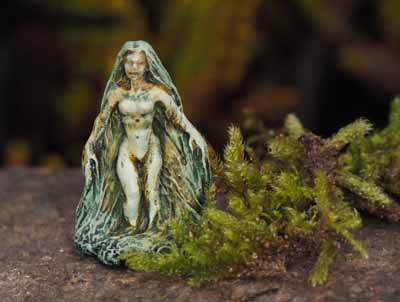
4.1 A Dr does not need to Activate their Nature Spirit, as does the Elementalist. It is within the Powers of Nature Spirits to be aware of when a Druidic Spell is being Cast, its Spell Level, and its location, anywhere within Their local Sub-Forest (or within 100 miles if outside it). The empathic and Mystic links between Their kind also help co-ordinate their response. However, a Spirit capable of producing the required effect must be within the specified Casting Range of the Spell in order for the effect to be produced. Whilst there are several instantaneous transport Spells available to the higher-level Spirits, and the lower-level ones are more likely to be present in the vicinity, this can still sometimes result in a few seconds delay between Casting and resolution of the Spell effect. This can occur in particular if a Dr Casts a Spell away from a Natural environment. If they were more than 100 miles from the nearest Nature Spirit, the Spell could fail completely. See 13.1.5.4 below for where the Higher Level Spirits of a Forest may dwell.
4.2 To prevent this happening, Drs may use a Summon Spirit procedure, which is learnt during Druidic IBT and calls a Spirit to the aid of the Druid regardless of whether it would be aware of a Druidic Spell being Cast.
4.2.1 The cost of doing so is:
Summoning Cost = (Spirit Level) SP, (IP*5) and seconds of Incantation in Old Speech
4.2.2 A specific Type of Spirit (e.g. a Dryad, Oread, etc.) may be Summoned by specifying it in the Incantation and by Actions and Materials. A specific individual Spirit may be Summoned by using Their True Name (if known) in the Level part of the Incantation. Otherwise the nearest Spirit of the specified Level of the local Type will usually be Summoned. Cultist IBT includes the appropriate Old Speech Incantations for the Spirits associated with the Cult's Spell Cycles.
4.2.3 Actions and Materials are not strictly necessary to Summon a Spirit, but it is customary to mirror the part of the Old Speech Incantation which indicates the Type of Spirit required by sketching the appropriate symbol by Actions, and using the matching materials. For example to Summon a Dryad, the Dr sketches a symbol of Lord NORRID, God of Trees, and uses a twig from the desired species of tree as Material.
4.2.4 If any of the necessary elements of the Summons (SP, IP or secs. incantation) are insufficient, the Spirit Level Summoned is ratioed by (element required) / (element used).
4.2.5 If the Dr has any outstanding IST, the Spirit Level Summoned is reduced by 1 per sec outstanding IST.
4.2.6 There is no Duration. A Spirit of the Type and Level Summoned will come as quickly as it can, and will follow the Dr, ready to produce their Spell effects, until Dismissed or the Dr runs out of IP.
4.3 Dismissal can be achieved formally, by an Old Speech Incantation taking the same time, actions and materials, but no SP or IP, or informally, by talking or gesturing to the Spirit. The Spirit may also infer an informal Dismissal from the Dr going to sleep or the start of a new Caeriad (when it is customary to perform a new Summons). If the Dr does not Cast any Druidic Spells for some time, it may even simply get bored or forget the Summons, and wander off. This can happen due to the lack of a continuing compunction from the Summons.
4.4 There is no penalty for Summoning multiple Spirits, though Summoning another is a good way of making the first think They have been informally Dismissed - especially if the new one is of the same Type or higher Level.
4.5 There is no Conference procedure akin to that for Elementalist Magic-Using. If the Dr wishes to converse with a Spirit, for Spell learning or otherwise, they must spot their Summoned Spirit, attract Their attention, and converse with Them. The same can be done for Spirits not previously Summoned, though a Summoning helps in spotting one.
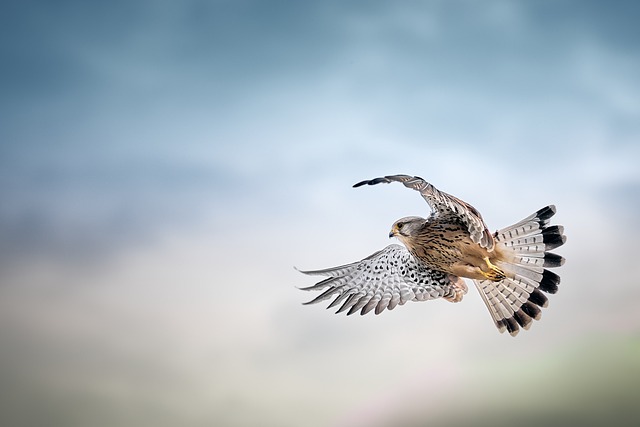
"I caught this morning morning's minion, king-
dom of daylight's dauphin, dapple-dawn-drawn Falcon, in his riding
Of the rolling level underneath him steady air, and striding
High there, how he rung upon the rein of a wimpling wing
In his ecstasy! then off, off forth on swing,
As a skate's heel sweeps smooth on a bow-bend: the hurl and gliding
Rebuffed the big wind. My heart in hiding
- Stirred for a bird, - the achieve of; the mastery of the thing!"
(from The Windhover, by Gerard Manley Hopkins)
5.1.1 Nature Spirits will only help those who truly appreciate Nature. In systems terms, a Dr's current level of appreciation of, and attunement to, Nature is measured in Instress Points. IP are gained by appreciating ("instressing") the individual or essential quality of Nature (its "inscape") - terms coined by the Victorian poet, Gerard Manley Hopkins. IP are expended by Casting Druidic Spells, or simply by the passage of time.
5.1.2 The expenditure of physical and mental energy that is represented by the use of SP must, for Druidic Spells, be made in a state of mind and body that is at one with Nature. As SP expenditure tires the Caster, so IP expenditure reduces their attunement to Nature.
For each 1SP expended for Druidic purposes, 5 Instress Points ("IP") must be expended or the SP are wasted, and vice versa.
Expenditures of less than 5IP or of IP without SP are ineffective (except to expend the IP).
5.1.3 Anti-Druidic Spells require the expenditure of negative IPs, in the same ratio of -5IP per 1SP.
5.2.1 Inscape is the inward essential quality of Naturalness present within the Natural World. For living creatures it is a measure of the 'lifeforce', equivalent to At in higher creatures. Strictly speaking it is calculated as follows:
Ic = (St + Dx(Ph) + (2 * (Co + Bt + Mn))) / 8
Where "Mn" is Mind, or mental awareness, being the average of the creature's mental Chars. Creatures of Nature, especially the lower forms, do not usually have separate mental Chars. An example of a higher form with separate mental Chars is the Mule, which has high Wp, but low In. However, it is rarely necessary to make such a detailed calculation for each individual specimen. Typical Inscape figures may be used, as set out for the woodlands in the Is Table below. These may be varied at the DM's discretion. An average figure (good specimen) of a creature of Nature is 5.
5.2.2 To an extent, Ic is a subjective judgment by the observer. The figures referred to above represent a conventional appreciation of Nature by Drs of the woodlands. Drs from different environments may appreciate different qualities of those environments, and so become more attuned to particular aspects of Nature, but less to others. To reflect these cultural differences, the typical Ic figures are varied for Drs whose Cult or Forest has taught them in their IBT to appreciate Nature differently (remember that these figures may be affected by Circs Mods in certain areas):
| Ic Table | Woodlands | Mountains / Caves | Plains / Tundra | Deserts | Icelands | Seas |
| Mammals | 8 | 8 | 6 | 7 | 6 | 4 |
| Reptiles | 6 | 3 | 6 | 7 | 1 | 3 |
| Birds | 5 | 6 | 5 | 4 | 4 | 4 |
| Fish | 4 | 4 | 2 | 1 | 2 | 8 |
| Insects | 3 | 1 | 2 | 4 | 2 | 0.5 |
| Trees | 5 | 2.5 | 2.5 | 2.5 | 0 | 1 |
| Plants | 4 | 2 | 2 | 2 | 1 | 2 |
| Organisms | 0.5 | 5 | 1 | 1 | 1 | 1 |
| Sand Dunes | 0 | 0 | 2.5 | 5 | 0 | 0 |
| Ice Crystals | 0 | 1 | 3 | 0 | 6 | 0 |
Note that in Anarea, whales and dolphins are Fish (not Mammals), mushrooms, toadstools and fungi are Plants, and worms, moulds, slimes, oozes and viruses are Organisms. Sand dunes and ice crystals are not creatures at all, but are part of the Natural environment in respect of which Druidic Spells may be Cast (like Fire and Earth for conventional Drs).
5.2.3 As the above appreciations are learnt during IBT, a Dr from a different culture who travels to a new Forest may not choose to instress using the local figures, but must continue to use those they originally learned. For example, a Tree Cultist who travels to the Icelands will not appreciate the patterns of ice crystals. However, it is possible to retrain with local Drs, if they are willing, and learn the local culture in addition to one's own (ULT = four Seasons; i.e 1 year). In such a case, the Dr will use the appropriate column of the Ic Table for the Forest they are visiting - they may not pick and choose the highest Ic available to them for a particular specimen. In unfamiliar Forests they will revert to the culture of their IBT.
5.2.4 The Dark Forests have negative Ic (Discape), but decaying Light Side Forests still have positive Ic; e.g. a tree in autumn foliage still has positive Ic. However an individual specimen may be corrupted by the Dark Side and have negative Ic.
Instressing is the way the Dr appreciates Nature, and so gains IP. It involves the feeling within oneself of the Inscape of the Natural World. See the above poem for an example of instressing by the poet (though it is not necessary to compose such poetry each time your Dr instresses!).
IsC is the measure of how good a Druid is at instressing.
IsC = (ChMod[Nt] + DrL)/10 FRX
IsC is multiplied by -1 for Anti-Druids and known as Distress Capability ("DsC").
To calculate the number of IP gained from instressing a particular specimen:
IP gained = (Ic of subject) * (IsC of Druid) * (Circs Mod)
Where "Circs Mod" is the Circumstances Modifier. In average natural conditions for a Dr native to the Forest, Circs Mod will usually be 1. See 14. below for environmental variations in the base Circs Mod. For instressing purposes (only - not for Spells affected by Circs Mod, unless their Specifications expressly say so), Circs Mod may also be affected by factors subjective to the Dr's appreciation of Nature. For example if they are accompanied by a party unappreciative of Nature, or are simply tired.
For each SP use break point and for each 1 sec IST currently affecting the Dr, deduct 0.1 from Circs Mod.
At midnight (in the Overworld or Underworld) the Dr's current IP total is halved, FRX. A Dr who travels between the Overworld and Underworld will suffer the halving effect once only every Caeriad, during the middle of their rest period.
It should not normally be necessary to work out a Dr's exact IP total in great detail. A rough calculation will usually suffice. For example, in average woodland conditions, assuming one Instress per 15 min, a Dr with IsC 1 would gain c250IP in 12Ĺ hrs, reaching a maximum 'oneness' with Nature at c500IP, and going from 250 to 500IP each Cd when Instressing constantly without Casting Spells, and suffering the halving effect each midnight.
The Instress Table gives the IP totals at midnight of each Cd for a Dr instressing a constant 1IP / Cd (multiply by the appropriate amount for other figures):
| Day 1 = | 1 IP | 7 = | 1.984375 | 13 = | 1.9997558 |
| 2 | 1.5 IP | 8 | 1.9921875 | 14 | 1.9998779 |
| 3 | 1.75 | 9 | 1.9960937 | 15 | 1.9999389 |
| 4 | 1.875 | 10 | 1.9980468 | 16 | 1.9999694 |
| 5 | 1.9375 | 11 | 1.9990234 | 17 | 1.9999847 |
| 6 | 1.96875 | 12 | 1.9995117 | 18 | 1.9999923 |
etc. (1.9999999 being reached on Day 25)
In practice, as the Instress Table shows, maximum IP are reached after approx. 1 week, and will remain maximum from then on, assuming consistent instressing as above.
5.3.5.1 Anti-Druids instress negative inscape (which they refer to as Distressing Discape ("Dc")) and go negative on IP (which they refer to as Distress Points ("DP")). A Druid who instresses from a specimen with negative Ic will lose IPs and may go negative (and conversely for Anti-Druids).
5.3.5.2 Specialist Anti-Druids who appreciate both the Light and Dark Sides of Nature may Instress and Distress separately and calculate their current IP and DP as separate figures, being able to hold both at the same time. They can therefore Cast both Druidic and Anti-Druidic Spells, provided they have sufficient IP and DP and that appropriate Light or Dark Spirits are available. As Light and Dark Spirits do not normally co-exist in the same Forest, the latter may often be a limiting factor. Such an appreciation risks Madness, so such specialists usually have high Wp and DrL.
6.1 Druid Level ("DrL") is the basic measure of a Dr’s proficiency at Druidic Magic-Using. Non-Drs have DrL 0.
6.2 DrL 1 is gained by completing Druidic Initial Basic Training ("IBT"). DrL above 1 is gained by earning Druidic Experience. Continuous Level Advancement ("CLA") applies, in that the exact DrL (usually expressed to 4 decimal places) is used in all calculations involving DrL.
6.3 As a Dr gains Higher DrLs they will be:
dependent on their particular Cult. They may also be appointed to particular roles or ranks within their Tribe or Cult, e.g. Seer, Shaman, Elder, Archdruid or Guardian.
7.1 The Powers of Nature Spirits, as with other Elementals, are defined (in Old Speech) in a wide and general way within Their speciality and up to a maximum limit dependent on Level (see the table in 3. above). Druidic Spells represent specific instances of the use of these Powers. They are a way of calling on a Nature Spirit to help the Dr by using Their Powers in the way specified by the Spell. They were originally taught to Drs by the Spirits, but as they could also be taught by a Dr to another Dr a standard Druidic Spell List became established, and was even codified by the more academically-minded Drs (in oral, rather than written, form, as is traditional amongst Drs - although some Sages and bookish Cults have written down Spell Lists).
7.2 A Dr may learn any Druidic Spell from the standard Druidic Spell List (or the standard list applicable to their particular Cult) either by tuition from a Nature Spirit capable of producing the Spell or from a Druid who knows it. The tutor must be present for most of the learning time of the Spell (some practice can be done on the pupil's own).
7.3 A Dr may not learn a Spell from a Spell Cycle not on the Spell List of their Cult (but may use a Druidic Command to achieve an equivalent Effect). To train in the ways of another Cult requires at least two Seasons (half a Year) of adiditional IBT, assuming that Cult is willing to teach the Druid. This may be combined with retraining in appreciating the Cult's Ic. Some Cults are deadly enemies of each other, so will not accept members of the enemy Cult. Once trained in the ways of multiple Cults, the Druid may access the Spell Lists of all those Cults, but where a Spell has different Spell Levels for different Cults, they will Cast it at the Level applicable to the Cult they most recently trained in.
7.4 Going over to the Dark Side (or from the Dark to the Light Side) can be a quicker process (usually involving going Mad, or recovering sanity). The Druid's learnt Spells will then convert into their Dark (or Light) side equivalents. However it can still take up to a Season to adjust to the changes - if one survives the descent into Madness.
7.5 Non-Standard Druidic Spells are possible, but are rarer than in Elementalism (partly due to the availability of the Druidic Commands). A Nature Spirit will not teach a Spell from a Cultist Spell Cycle (or a Spell with an equivalent Effect) to a Druid not of that Cult as a Non-Standard Spell. A Light Side Druid may learn a Dark Side Spell (or vice-versa) from a Dark (or Light) Spirit, but that is the beginning of the slippery slope to the Dark (or Light) Side.
7.6 Written copies of Druidic Spells are rare, but if one is found a Druid who fully reads OS can learn from it, in which case no tutor is required, but ULT is increased by 10% due to the lack of coaching from the tutor. A Dr who has learnt Old Speech to Know and Read and has learnt a Druidic Spell may write down a Druidic Spell on a scroll (or other method, depending on culture), from which it may be learnt by other Drs. This is rare amongst most Drs, due to the oral tradition (the main exception being the Spider Cults, who have their own libraries).
7.7 The ULT of each Druidic Spell is given in its Spell Specification. The average ULT of Druidic Spells is (Spell Level) * 8 hours. They are more complex to learn than Clerical Spells, due to the Incantations being in Old Speech, but do not have the same tortuous complexity as Elementalist Spells, because it is not necessary to be so precise in tone and inflexion in instructing Nature Spirits (which are generally well-disposed to Drs) as it is in instructing Elementals (which generally object to Spell producing duties). The minimum learning time for any Spell is 1 hour. If insufficient learning time has been spent on a Spell, ratio all Throws on Casting it by (Learning Time expended) / (Learning Time required) until the learning time has been completed.
7.8 Each Dr Spell learnt counts as 1LL. Druidic Commands count as 2LLs. For each 2LLs, or part thereof, overlearnt, the Dr takes -1 on all Dr Spells. There is no bonus on Druid Spells for Unfilled Spell Levels.
Every Druidic Spell falls within a particular Spell Cycle. These correspond to the broad areas of influence of the specific Powers of Nature Spirits (as explained at 2. above). All Spirits have the Powers to produce Spells within the four standard Cycles listed below (subject to level constraints as in the table in 3. above).
Spells of the Sered Cycle are concerned with all things Vegetable (Trees, Plants, and their products). Its associated Medium is privet, and its associated colour is black.
Spells of the Yribt Cycle are concerned with all things Animal (Mammals, Reptiles, Birds, Insects, and Organisms, and their products). Its associated Medium is holly, and its associated colour is red.
Spells of the Ranian Cycle are concerned with the command of Elementals of Earth, Water, Air, Fire, Gravity, and the Planes in their interaction with Nature. Its associated Medium is ivy, and its associated colour is yellow.
Spells of the Druid Cycle are concerned with the interaction of Nature with itself, the World, and Higher Beings. Its associated Medium is mistletoe, and its associated colour is white.
The various Druidic Cults have their own unique Spell Cycles. To Cast a Spell within one of these Cycles a Spirit of the appropriate type is required (e.g. a Dryad for the Sered Cycles of the Tree Peoples, or a Geleid for the Shamanic Cycle of the Readers of the Pattern).
8.2.1 Each Spell Cycle has its own Druidic Command. These are Druidic Spells of general application within the Cycle, rather than limited to a specific effect. Each allows the Dr to Command whatever they will within the influence of that Cycle, with the chance of success depending on the Throw they achieve on the Spell. To produce any given Effect, the specific Spell is generally more efficient, but the Commands are more flexible, especially as they allow non-standard Effects within the Cycle to be produced.
8.2.2 The Command is stated by the Caster in any language (preferably Old Speech), immediately after the Incantation for the Druidic Command Spell. The Effect is resolved immediately after the Command has been stated.
8.2.3 The Druidic Commands for the four standard Cycles, and their Spell Levels, are as follows (together with their Anti-Druidic equivalents).
| Druidic Commands | Anti-Druidic Commands |
| 3. Sered Command | 3. Deres Command |
| 5. Yribt Command | 5. Tbiry Command |
| 7. Ranian Command | 7. Nainar Command |
| 9. Druid Command | 9. Anti-Druid (or Diurd) Command |
8.2.4 The Druidic Commands for the non-standard Spell Cycles are listed in the Spell Lists for the applicable Cults.
8.2.5 The Druidic Commands have LL of 2 each. They are restricted to Drs who have reached a degree of competence sufficient for them to be trusted with such powerful Spells. Therefore a Dr may not learn a Druidic Command before they have achieved DrL = (Spell L of Command). Spirits and other Drs will not initiate them into its mysteries until then, or allow them access to the (rare) scrolls describing them.
8.3.1 Non-Cultist Druids (i.e. those who have taken the Standard Druidic Spell List or Standard Anti-Druidic Spell List rather than the Spell List of a particular Cult) may use those Druidic Commands they have learned to produce the Effects of any Cultist Spells, subject to the following restrictions:
8.3.2 Cultist Druids may not use Druidic Commands to request the effects of the Spells of other Cults, unless those effects would also be available as a Spell to their Cult.
9.1 Druidic Shapechange is an innate Magical Power Delegated for life by a Nature Spirit of Level ≥6 to those who reach DrL6. As it is a Power, not a Spell, it does not take up LL, and no Spirit is required to produce the Effect. It allows the Dr to Shapechange three times per Cd, once each to a Mammal, Reptile, and Bird, from Sz1 to 20, losing (10xD6)% Dam on each change (and the change back). No SP are needed, but if the Dr has <25IP, there is a percentage chance of success of (4*IP)%. The IP are not expended. The change take 1/5 sec per point of Sz difference and the Dam loss takes place evenly over the period of the change. There is no Duration, but a prolonged stay in Animal form can make the Dr think like the Animal and forget to turn back.
9.2 Drs of certain Cults may be granted a different Power instead of Shapechange. For example, Anti-Druids are granted Walk the Otherworlds at DrL6.
Drs may obtain pluses on the Casting of Druidic Spells by the use of Druidic Media. The Medium must be harvested in advance, and is then expended in Casting, after which it will not have any future effect as a Druidic Medium. Media are separate from, and additional to, Materials for each Spell. Media may optionally be used for a plnus, and there is no penalty if they are not used.
The standard Druidic Media for each of the standard Spell Cycles are as follows:
 Privet is the associated Medium for all
Druidic Spells of the Sered Cycle. It gives maximum pluses when harvested
on the Mid-Spring Caeriad (13 Varech).
Privet is the associated Medium for all
Druidic Spells of the Sered Cycle. It gives maximum pluses when harvested
on the Mid-Spring Caeriad (13 Varech).
Broom is a common alternative Medium for Druidic Spells of the Sered Cycle amongst local Druids in areas where privet is not a native plant, e.g. much of the Underworld. (Note Druids for whom privet is their normal Sered Medium may not substitute broom, even in an area where privet is not native - and vice-versa.)
The associated Medium for Anti-Druidic Spells of the Deres Cycle is nettles. They give maximum pluses when harvested on the Midsummer Caeriad (26 Oscow).
 Holly is the associated Medium for all
Druidic Spells of the Yribt Cycle. It gives maximum pluses when harvested
on the Midwinter Caeriad (26 Yarom, or 25 Yarom in a leap year).
Holly is the associated Medium for all
Druidic Spells of the Yribt Cycle. It gives maximum pluses when harvested
on the Midwinter Caeriad (26 Yarom, or 25 Yarom in a leap year).
The associated Medium for Anti-Druidic Spells of the Tbiry Cycle is brambles. They give maximum pluses when harvested on the Mid-Autumn Caeriad (12 Garrack).
 Ivy is the associated Medium for all Druidic
Spells of the Ranian Cycle. It gives maximum pluses when harvested on the Mid-Autumn Caeriad (12 Garrack).
Ivy is the associated Medium for all Druidic
Spells of the Ranian Cycle. It gives maximum pluses when harvested on the Mid-Autumn Caeriad (12 Garrack).
The associated Medium for Anti-Druidic Spells of the Nainar Cycle is bindweed. It gives maximum pluses when harvested on the Mid-Spring Caeriad (13 Varech).
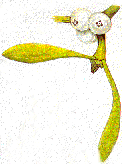 Mistletoe is the associated Medium for
all Druidic Spells of the Druidic Cycle. It also has half effect as a
Medium for the other Spell Cycles. It gives maximum pluses when harvested
on the Midsummer Caeriad (26 Oscow).
Mistletoe is the associated Medium for
all Druidic Spells of the Druidic Cycle. It also has half effect as a
Medium for the other Spell Cycles. It gives maximum pluses when harvested
on the Midsummer Caeriad (26 Oscow).
The associated Medium for Anti-Druidic Spells of the Anti-Druid Cycle is killer vines. They also have half effect as a Medium for the other Anti-Druidic Spell Cycles. They give maximum pluses when harvested on the Midwinter Caeriad (26 Yarom, or 25 Yarom in a leap year).
Certain Druidic Cults may have their own unique associated Media for their unique Spell Cycles and/or for the standard Spell Cycles and/or for individual Spells. They may not substitute the standard Druidic Medium for a standard Spell Cycle for which they have a different Medium.
The plus given by a Medium to the Casting of a Druidic Spell within its associated Cycle is determined by how and when it was harvested, as follows:
10.2.1 If obtained from another: +1; or10.2.2 If harvested oneself:
10.2.2.1 If picked: +2; or
10.2.2.2 If cut with a sickle: +3; or
10.2.2.3 If cut with a golden sickle: +4; or
10.2.2.4 If cut with a sickle and caught in a bowl: +6; or
10.2.2.4 If cut with a sickle and caught in a bowl (only one of which is golden): +7; or
10.2.2.4 If cut with a golden sickle and caught in a golden bowl: +8; and
10.2.2.5 In addition to the appropriate above plus for harvesting oneself, if harvested on the Cd specified in 10.1 above as giving maximum pluses when harvested then: +5, giving a maximum total plus usually achievable of +13.
For Anti-Druids a silver sickle and silver bowl are used in place of golden ones to obtain the above pluses. Other Cults may have their own unique ways of gaining pluses from their Media.
10.2.3 Mistletoe gives half the above pluses (FRD) on Spells of Cycles other than the Druid Cycle / Killer Vines give half the above bonuses (FRD) on Anti-Druidic Spells of Cycles other than the Anti-Druid Cycle
10.2. 4 Further pluses are rumoured to apply under unusual conditions, e.g. if harvested at specific locations with exceptionally high Circs Mods, if the Dr planted the plant themself, or if the golden tools were made by the Dr themself, at Midsummer, and never touched by any other living thing, etc. Many of these are probably myths, but some Drs become fanatical about their harvesting tools for this reason, adopting such eccentricities as washing them every sunrise in pure streams.
10.2.5 When harvesting Media, the Dr must take no more than they need, and no more than prunes the plant (where applicable) and does not harm its future growth. Excessive harvesting will reduce the pluses given.
10.2.6 The encumbrance of Druidic Media is 0.1 wt pts per Medium.
At midnight of each New Moon, all harvested but unused Media reduce in plus effect by -1. E.g. +13 mistletoe harvested on 26 Oscow 2503 reduces to +12 at midnight of 17 Estender 2503. A Dr who travels between the Overworld and Underworld will take the reduction at midnight in the Overworld for media harvested in the Overworld or at midnight in the Underworld for media harvested in the Underworld.
10.4.1 To gain the plus in a Spell Cast, the Dr must be touching the Medium so as clearly to indicate it is being used. Only one Medium can be used per Spell Cast (if more than one is indicated, the one giving the greatest plus is effective). Each Medium may be used only once. Use in a Cast withers the Medium (as a side effect of the Magical request to the Spirit being channeled through it).
10.4.2 The maximum plus to a Druidic Spell Cast which may be obtained from Media without using additional SP and IP is whichever is the lesser of (DrL of Caster) or (Plus given by Medium). (This para added with effect from 26 Oscow / Day 177 2503.)
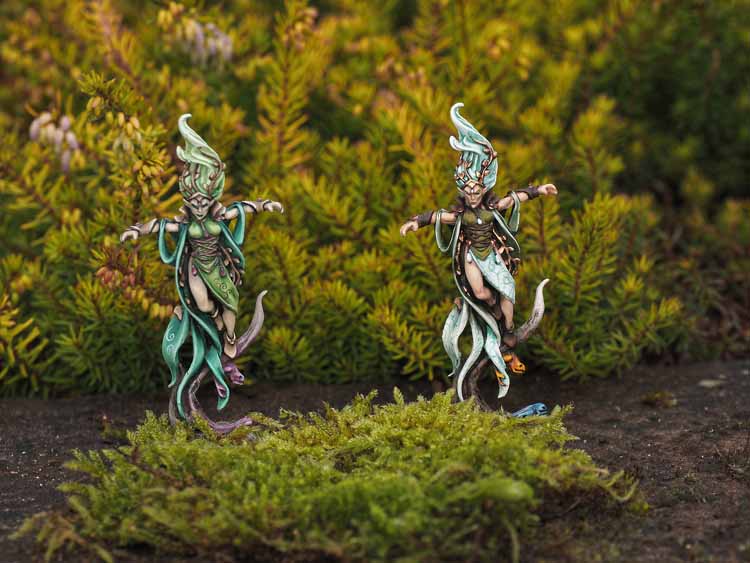
The final Spell Throw ("T") of a Druidic Spell is determined by taking the Spell Roll ("R") on 3d6, adding the pluses on the Spell ("+s"), applying any ratios to T, and then deducting any minuses on the Spell ("-s").
Spell Throw ("T") = ((R + (pluses)) / (ratios) ) + (minuses)
If a Spirit capable of producing the Spell Effect has been Summoned, T cannot exceed the maximum Throw of which They are capable (see the table in 3. above).
Spell Roll ("R") = 3d6 (RUD)
11.2.1 R represents the Spirit’s element of discretion in producing Spell Effects. It must be in the range of 1 to 20 (inclusive), and the 3d6 rolling up or down on 18 or 3 represent the average spread of results Spirits are supposed to give. However, Spirits are of a somewhat mercurial temperament, and R can therefore be affected by subjective factors. A proper respect for Nature and a good working relationship with the Spirit are therefore advisable on the part of the Dr.
11.2.2 Drs may get +s or -s to R for their relationship with a particular Spirit, as may Elementalists with Elementals, but as Spirits tend to live for the present, this is a more short term effect, which may be gained (and lost) fairly quickly. The effect is longer term with higher level Spirits, particularly those with more senior responsibilities within Their Forests.
11.2.3 If R is rolled up or down to 20 or 1, continue rolling up or down, as Spirits may ignore or overlook the usual rules.
Calculate a Dr’s Base Plus on each Druidic Spell they have learned as follows:
Base Plus = (2*DrL) - (Spell Level) + (ChMod [Nt]) + (ChMod/2 [Dx(M)]) - (2 * OSLs) + (Spell Level, if F in OS)
In detail:
DrL gives +(2*DrL) FRD on all Druidic Spells
i.e. the Dr gets a +1 bonus to all Spells for each 0.5 of a DrL.
Spell Level gives a + of -(Level of Spell) on all Druidic Spells
Note that this is applied as a negative plus (before ratios) rather than as a minus (after ratios).
Chars give +s or -s on Druidic Spells as follows:
The above +s are cumulative, but are applied separately (so any -s are applied after ratios).
Each 2 Overlearnt Spell Levels ("OSLs"), FRU (i.e. SLL learnt in excess of those available) give -1 on all Druidic Spells. See 7. above.
Fluency in Old Speech gives + (Spell Level) on all Druidic Spells.
Part fluency gives +s as follows:
|
SL/LP |
10 |
20 (K) |
30 |
40 |
50 |
60 |
70 |
80 |
90 |
100 (F) |
|
1 |
+0 |
+0 |
+0 |
+0 |
+0 |
+0 |
+0 |
+0 |
+0 |
+1 |
|
2 |
+0 |
+0 |
+0 |
+0 |
+0 |
+0 |
+0 |
+0 |
+1 |
+2 |
|
3 |
+0 |
+0 |
+0 |
+0 |
+0 |
+0 |
+0 |
+1 |
+2 |
+3 |
|
4 |
+0 |
+0 |
+0 |
+0 |
+0 |
+0 |
+1 |
+2 |
+3 |
+4 |
|
5 |
+0 |
+0 |
+0 |
+0 |
+0 |
+1 |
+2 |
+3 |
+4 |
+5 |
|
6 |
+0 |
+0 |
+0 |
+0 |
+1 |
+2 |
+3 |
+4 |
+5 |
+6 |
|
7 |
+0 |
+0 |
+0 |
+1 |
+2 |
+3 |
+4 |
+5 |
+6 |
+7 |
|
8 |
+0 |
+0 |
+1 |
+2 |
+3 |
+4 |
+5 |
+6 |
+7 |
+8 |
|
9 |
+0 |
+1 |
+2 |
+3 |
+4 |
+5 |
+6 |
+7 |
+8 |
+9 |
|
10 |
+1 |
+2 |
+3 |
+4 |
+5 |
+6 |
+7 |
+8 |
+9 |
+10 |
SL/LP = Spell Level is in left-hand column / Language Points towards Know & Fluency are in the top row.
There are no Experience pluses and bonuses on Druidic Spells, as there are on El'ist Spells.
Calculate a Dr’s Casting Plus on each Casting of a Druidic Spell as follows:
Casting Plus = (Base Plus) + or / (Power) - or / (Incantation) * ((Actions used) / (Actions required)) * ((Materials used) / (Materials required)) + (Media) - (secs. IST) - (Varied Parameters) - (SP Use & Fatigue Break Points)
Note that the Casting Plus may include minuses or ratios to T. Remember to apply pluses first, then ratios, then minuses.
In detail:
The Base Cost in Power of a Druidic Spell = ((Spell Level) + 1) SP & 5*((Spell Level) + 1) IP
As with all Magic-Using, Spell Points are expended by mental and physical effort put into Casting. IP are expended the same way (see 5.1 above).
Note that Anti-Druids expend DPs (negative IPs) to Cast Anti-Druidic Spells at the ratio of 5DP to 1SP.
Extra SP and IP (or DP) expended over Base Cost give +s as follows:
i.e.
|
+ on Spell |
+1 |
+2 |
+3 |
+4 |
+5 |
+6 |
+7 |
+8 |
+9 |
+10 |
+11 |
+12 |
+13 |
etc. |
|
Extra SP |
3 |
6 |
10 |
15 |
21 |
28 |
36 |
45 |
55 |
66 |
78 |
91 |
105 |
etc. |
| Extra IP | 15 | 30 | 50 | 75 | 105 | 140 | 180 | 225 | 275 | 330 | 390 | 455 | 525 | etc. |
[prior to 26 Oscow / Day 177 2503 the above read as follows:
Extra SP and IP expended over Base Cost give +s as follows:
i.e.
|
+ on Spell |
+1 |
+2 |
+3 |
+4 |
+5 |
+6 |
+7 |
+8 |
+9 |
+10 |
+11 |
+12 |
+13 |
+14 |
+15 |
etc. |
|
Extra SP |
1 |
2 |
3 |
4 |
5 |
7 |
9 |
11 |
13 |
15 |
18 |
21 |
24 |
27 |
30 |
etc. |
| Extra IP | 5 | 10 | 15 | 20 | 25 | 35 | 45 | 55 | 65 | 75 | 90 | 105 | 120 | 135 | 150 | etc. |
]
Reducing SP below base cost gives a ratio to T of (SP used) / (SP required).
Reducing IP has the effect of preventing SP from being effective. Only an expended SP for which a whole 5IP are also expended counts towards the Casting. (Previously a ratio was applied.)
The Incantation for each Spell is in Old Speech, and is learnt with the Spell (even if the Dr has learnt no other Old Speech). The Incantation must be clearly declaimed (unless cast by thought or reflex). Silence Spells and like effects which prevent the Incantation being heard do not affect Casting, provided the Dr has clearly declaimed the Incantation before such effects are applied (as the Nature Spirit is still aware of the Incantation).
The Base Casting Time of a Druidic Spell = ((Spell Level) + 1) seconds.
There are no Druidic Word Spells.
Extra casting time over Base Casting Time gives -n(n+1)/2 to the Spell for n extra sec.
Reduced casting time under Base Casting Time gives -n to the Spell for n less sec., down to 1 sec, and then a ratio of the fraction of 1 sec. taken. E.g. a L3 Spell has a base casting time of 4 sec, so to cast it in 1/4 sec gives -3 and a ratio of 1/4.
Casting in £ 1/4 sec is as a Thought Spell.
Casting in £ 1/10 sec is as a Reflex Spell.
Most Spell Specifications require certain actions. The Actions for Druidic Spells usually involve rapid arm movements, designed to give the Spirit a visual representation of which Spell is being Cast, and sometimes to give some detail of what is required or to facilitate the carrying out of the Spell.
When Casting in £ 1/2 sec, Actions may be dispensed with. They may also be dispensed with where inappropriate or practically example, but this category is very narrowly interpreted by Spirits, who like to see some Actions (an example is where the Dr is Shapechanged into a form physically incapable of the Actions, but even so snakes, for example, are expected to use their tongues).
Pure Action Spells, with no spoken Incantation, are not possible for Druidic Spells as they are for El'ist Spells, due to the imprecision of Druidic Actions.
Spells may be cast one-handed, at a ratio to T of 2/3.
Spells cast in < 1 sec require finger movements only for Actions.
If Actions are required but omitted, ratio T by (Actions used) / (Actions required).
Materials are most important in Druidic Spells. They fall into two categories, each of which may apply to any one Spell Cast:
Most Spell Specifications require certain Materials in order to give the Spirit something to work on, described as a "basis" for the Spell (e.g. a flame for Spells of the Ranian Cycle involving Fire). In some cases the Materials are essential, and the Spell cannot therefore be Cast without them (e.g. Sticks to Snakes requires dead wood or at least one snake).
When Casting in £ 1/2 sec Materials as bases may be dispensed with, unless they are essential.
If Materials are required but omitted, ratio T by (Materials used) / (Materials required).
Materials as Media are used to give pluses on Spells, and may be dispensed with without penalty. See 10. above for the pluses given by Media. Note that they are limited to +DrL.
Each second of outstanding IST gives -1 to the Spell.
The variable parameters of each Spell are listed in its Specification. If no variation of the parameter is specified, the Spell will have the standard parameter given, where the variable = 1. Except where specified otherwise, the minuses for varying parameters are applied to T. FRU on all variable parameters, e.g. if the Radius parameter is:
10r ft -r(r+1)/2
to cast the Spell with a 35 ft radius, r = 4, giving -10 to T.
Parameters are varied by inflexions to the Old Speech of the Incantation.
For each SP Use Break Point, the Dr takes -1 on all Druidic Spells. E.g. if they fall below 1/8 of their SP total, they take -3 on Spells.
For each Fatigue Break Point, the Dr takes -1 on all Druidic Spells.
See the Specification for the Spell for the Effect of T. Each Spell has a range of results for T which give one of:
There are no Blowback or Insanity effects or penalties for failed Druidic Spell Casts.
12.2.1 Druidic Counterspells are of the Druid Cycle.
12.2.2 Pure Counterspells are freely available at any level from 1 to 10, but not as Word Spells. They succeed on the usual Throws, giving a Subtraction Effect of:
(T - ((Usual Throw for success)-2)) / 2 , FRD.
12.2.3 Extendable Counterspells with a Variable Parameter of:
Protection Period: 1p sec; -p(p-1) / 2
can be learnt at a cost of +1 to Usual Throw for success.
12.2.4 Reflex Counterspells are available from 21 I 2506 as Non-Standard Spells.
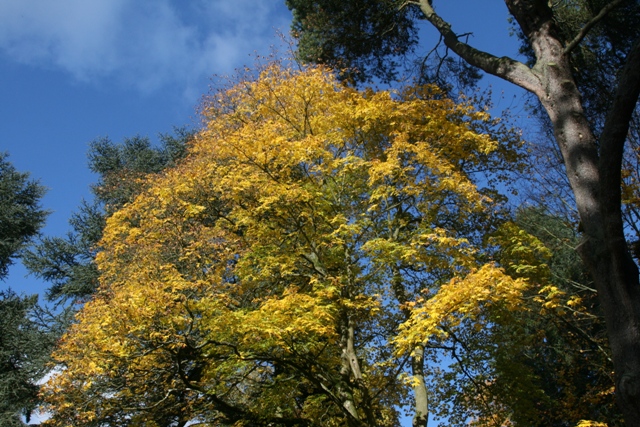
The Natural Worlds of the Overworld and Underworld are comprised of a number of Forests. Although a number of these are actual forests, the word in its Druidic sense means an entire ecosystem, and may therefore include an area with very few, or even no, trees. The Deserts, Seas, and even the Icelands are therefore Forests. Mountain ranges may be Forests in their own right and/or mark the boundaries between Forests. Unless clearly delineated by a watershed or shoreline, the exact boundaries between different Forests and Sub-Forests can be fluid, depending on the relative influences of the local Nature Spirits on each side.
The Major Forests of the Overworld are as follows, listed in the order in which they are commonly Linked from Sacred Heart Circles (counting deasil):
Mount Anar has no Forest,
There exist lesser Forests of the Overworld, which are either Sub-Forests of the above (e.g. the Forest of the Kingdom of the North forms a subsidiary part of the North West Forest) or Minor Forests in their own right (e.g. the island of Kyr is a separate Forest). For example:
The Major Forests of the Underworld are as follows, listed in the order in which they are commonly Linked from Sacred Heart Circles (counting widdershins):
Hell has no Forest.
There exist lesser Forests of the Underworld, which are either Sub-Forests of the above (e.g. individual Lands, Deserts, Mountain Ranges and Seas within the above areas) or Minor Forests in their own right (e.g. the Forest of RAVAR is a separate Forest). The Great Desert, the Icelands and the Sea of CASPIS form part of the corresponding Forests in the Overworld, straddling the Wall at the Edge of the World. Some lands or Deserts have virtually no Forest left (e.g. the Great Orcish Empire, the Desert of Despairing).
A list of possible Forests from which to select as the Druid's home Forest is included as a drop-down list in the "Forest" field in the "Druidic Abilities" tab of the latest version of the Random Character Specification spreadsheet and the full list may be consulted in the "Forests" column to the right. Wandering or Hedge Druids should select "None" here.
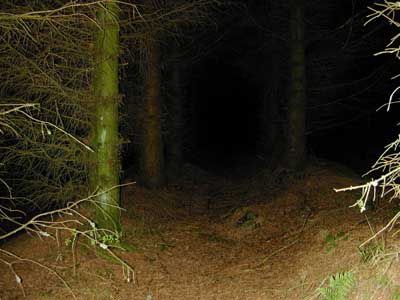
13.1.3.1 Each Forest, of the Overworld or Underworld, manifests in the Real World in its Light Side. The Dark Sides of the Forests, known as The Dark Forest, are to found in the Otherworlds of Dreams and Madness. If a wanderer in the Forest becomes lost to the Dreams of the trees, they can disappear into the Dark Forest, either in their Dream or physically too if they wander into the wrong place. This phenomenon is known as the Trance of the Trees. The Seekers of the Lost, a Druidic Cult of the North West Forest, were masters of these Mysteries and specialised in recovering such lost souls.
13.1.3.2 If a Forest, or more often part of it, tips over into the Dark Side, its Dark Forest manifests in the Real World and its Light Forest disappears into Dreams or Madness. This occurred in the North West Forest in Winter 2501-2 and in parts of the North East Forest in Winter 2504-5, and may be the usual state of some Forests of the Underworld. The AldaliŽ, the Druidic Tree Cult of the High Elves, are masters of these Mysteries and specialise in restoring the Balance between the Light and Dark Forests.
13.1.4.1 The Druids are the Guardians of the Forests. Each Forest has its own Druidic hierarchy, led by a High Druid or Archdruid (of DrL 10 or higher). These hierarchies serve and protect their respective Forests. Their organisation varies from Forest to Forest, and different or rival Cults may be the Guardians of different Sub-Forests. It is said there are also Great Druids of the Overworld and Underworld respectively (of DrL 12 or higher).
13.1.4.2 Not all Druids belong to these hierarchies, just as not all Clerics belong to particular Temples. But most Druids have a connection to the Forest of their origin, where they grew up and/or completed their Initial Basic Training. Particular Forests may have their own non-standard Druidic Spells, which may be learnt by Druids connected to them.
13.1.5.1 Each Major Forest, Sub-Forest and Minor Forest has a focal point of its Life and Growth, which is usually marked by a Circle, of stones, trees, totem poles or other markers appropriate to the Forest and Guardian Cult. These are known as the Sacred Circles, or Circles for short. They typically consist of twelve standing stones, trees or totem poles, sometimes with a central altar stone, heart tree or master totem pole. Each stone/tree/totem in a Circle of a Major Forest is designated to represent another Circle in the same Forest, and often marked with a symbol or rune to indicate this, with the central one (the "Heart Stone, Tree or Totem") designated to refer to the Sacred Heart Circle.
13.1.5.2 The Sacred Hearts of the Major or Minor Forests are the central focal points of the Life and Growth of the whole Forest. They are marked by Sacred Heart Circles, or Heart Circles for short. Note that this terminology is used fluidly by different local Cults, so for example a Cult which controls the Sacred Circle of a Sub-Forest may consider that to be the Sacred Heart of their Cult.
13.1.5.3 Each Sacred Circle has a corresponding Dark Circle, usually in its corresponding Dark Forest. Each Sacred Heart has a corresponding Dark Heart.
13.1.5.4 The Druidic hierarchy of each Forest is based around, if not necessarily at, its Sacred Circles and Sacred Heart. They guard the Circles because to do so is to guard the Forest itself.
13.1.5.5 The Higher Level Nature Spirits of the Forest will also usually dwell at and guard its Sacred Circles, for example as the Dryad of the Heart Tree of the Circle. Typically:
The corresponding Dark Circles are guarded by Higher Level Dark Spirits. Their Levels are typically one less than their Light Counterparts, but the difference depends on the current Balance between the Dark and Light Sides of the Forest.
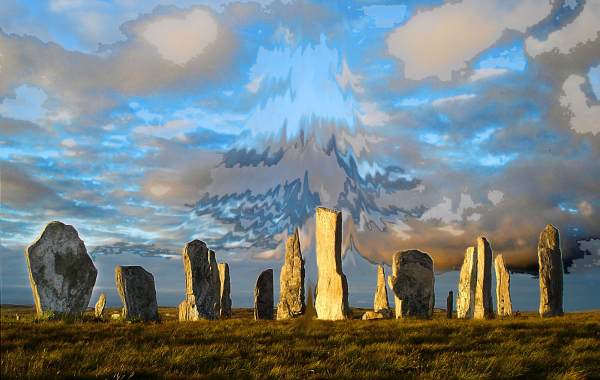
The existence of the Circles and the meaning of their markings can be deduced by any Druid of an enquiring mind with access to the Circles. The following Mysteries may be learnt from senior Druids or gathered from further experience of the Circles. They are given in ascending order of secrecy, with indications of the Druid (or other) Level at which an initiate may be ready to receive them. (However, this will always depend upon the judgement of the Druid Elders, and there is no right to this knowledge. Attitude and respect for the Cult are at least, if not more, important.) This is Restricted Information for Drs of lesser DrLs.
The Dream Kingdoms of Nature (or Natural Kingdoms) are the shared Dreamworlds of the Creatures of Nature. The higher species with a greater shared consciousness (such as Mammals, Reptiles and Trees) each have their own Dreamworld, with lesser species (such as Insects and Plants) generally sharing the Dreamworlds of the higher species.
13.2.1.1 The various Totem Animals of Beastmaster Cults, especially those which have a degree of shared consciousness through the herd or pack, have their own Dream Kingdoms, which are ruled by their Sponsors and may be accessed by their Cultists. These include the following:
13.2.1.2 The relevant Animals go to these Dream Kingdoms when they dream. They also access them when awake, as the shared consciousness of their ancestors is the source of instinct for the species.
13.2.1.3 Beastmaster Shamen who worship the totem of the animal concerned may walk its Dream Kingdom, either in spiritual or real/Shapechanged form (see the Dreamer System), as a member of the herd or pack. On reaching DrL 8 they are granted the Power physically to enter the relevant Dream Kingdom. Other interlopers in the Kingdom are likely to face hostility, especially if they do not show due respect.
13.2.2.1 The Trees of each species have their own Tree Kingdom ("Alvarda" in Quenya), which is shared with their associated Plants, including fungi of their mycorrizhal network, and smaller Animals that dwell amongst them. The following are as classified by the Galadhwaith of Taur Galen:
13.2.2.2 The Trees of other Forests have their own Tree Kingdoms, e.g. The Monkey Puzzle Kingdom of the Araucarias of the Caspian Mountains.
13.2.2.3 The Tree People Cults understand that Druidic Transportation via Trees is achieved via the appropriate Tree Kingdom, which links Trees of the same species even if they are in different Forests, and are able to use such Spells to enter the Tree Kingdom. On reaching DrL 6 they are granted the Power physically to enter the Tree Kingdom. Other interlopers in the Kingdom are likely to fall victim to the Trance of the Trees.
13.2.3.1 Each Natural Kingdom has its Dark Side, representing the Nightmares of its species. As the Natural Kingdoms exist in Dreams, the boundaries between their Light and Dark Sides are fluid and one can pass from one to the other as one's Dream progresses.
13.2.3.2 The Tree Kingdoms move at a slower pace than the Animal Kingdoms.
13.2.3.3 If a Forest tips over into The Dark Forest, the Tree Kingdoms of its Trees will become Dark Tree Kingdoms.
13.2.4.1 The Sacred Circles of Beastmaster Cults are circles of Totem Poles, each representing a particular Totem Animal. Each Totem is Linked to the Dream Kingdom of the Totem Animal as well as to the local Sub-Forest of which that Animal is the Totem. The Mist Warriors of the Overworld and the Beastmasters of Kargen of the Underworld have Circles of such Totems.
13.2.4.2 The Sacred Circles of Tree People Cults are circles of Trees. These are usually composed of the same species of Tree, appropriate to the local Sub-Forest (as this strengthens the Dreams of that species). However each is Linked to the local Sub-Forest of a different species of Tree as well as to the Tree Kingdom of that species, with the Heart Tree Linking to the Tree Kingdom of the local Tree.
13.2.5.1 Each Natural Kingdom also has its own Sacred Heart, where its Guardian dwells. Because these are Dreams, they may manifest in different ways to different visitors.
13.2.5.2 For Tree Kingdoms the Sacred Heart will invariably manifest as a Circle of Trees of the Dreaming species. These will reveal themselves to be Ents or Huorns. The Guardian will be the Heart Tree of the Circle, and may reveal Themself to be a Higher Power in Their Aspect of the Dreaming Species. For example, the Guardian of the Willow Kingdom may be OLD MAN WILLOW, an Entish Aspect of NORRID Himself, one of His Demigods or HAGENTI, Demon of Trees.
13.2.5.3 For Animal Kingdoms the Sacred Heart will usually manifest as a Lair of the Dreaming species, where dwell high level specimens of their related Monsters (e.g. Giant Rats at the End (Sacred Heart) of the Endless Burrows). The Guardian will be the Leader of the Pack, and may reveal Themself to be a Higher Power in Their Aspect of the Dreaming Species. For example, the Guardian of the Moonlit Kingdom may be THE GREAT WHITE WOLF, a Wolfish Aspect of ESCUS Himself, the Demigod of Wolves or LUPUS, Demon of Wolves.
14.1 Circumstances Modifiers ("Circs Mods") are a measure of the state of Naturalness of a place. They are expressed as the modifier they give to the Instress formula (see 5.3.2 above), but are also applicable to certain Spell Specifications. The Circs Mod of an area may be increased by the Naturalise Place Spell.
14.2 Typical Circs Mods are as follows:
14.3 The Circs Mod at the Heart Grove of Corinenda in MŪrlinnyrn has a Circs Mod of 3, as it is a City as well as a Greater Sacred Heart, but it increases to 4 when the Ritual to Maintain the Balance is performed on Midsummer's Night.
14.4 The highest Circs Mod recorded is 5, at the Sacred Grove of the North West Forest on its regeneration at the beginning of Spring and banishment of the Dark Forest on 3 Kemel 2502.
14.5 In areas of high Circs Mods (2 or above) the unwary (and non-Drs in particular) risk falling victim to the Trance of the Trees.
14.6 Places that are strong in the Dark Side of Nature have negative Circs Mods. Negative Circs Mods modify the Instress / Distress Formula in the same way as positive Circs Mods (ignoring any effects of multiplying negatives), but may only be used to boost Distressing. Positive Circs Mods have no effect on Distressing (but may make suitable subjects to Distress harder to find). Negative Circs Mods have no effect on Instressing (but may make suitable subjects to Instress harder to find - so it is hard to Instress in the Dark Forest, for example).
* Restricted Information: relevant Cultists and High Druids only *
Many Forests have their own unique Druidic Cults, which are adapted to their particular Nature. Such Cults have their own custom versions of the Druidic System and their own standard Spell Lists. If a Forest has a Cult or Cults, not every Druid in that Forest will be a Cultist. Some Cults are elite organisations (e.g. the Galadhwaith / AldaliŽ). Others are so adapted to their particular Forest that all Druids of the Forest are necessarily Cultists (e.g. the Readers of the Pattern, the Dolphin Riders). The main Druidic Cults are listed below.
Those Druids who are not of such Cults but form part of the orthodox Druidic Hierarchy of their Forest and use the Standard Spell List are known as the Ancient Order of Druids of the Overworld ("Druids of the Overworld" for short) or the Hidden / Secret Order of Druids of the Underworld ("Druids of the Underworld" for short). Wandering Druids with no affiliation to a particular Forest or Cult are known as Hedge Druids, or simply Wandering Druids.
Lists of possible Druidic Cults and their Sub-Cults from which to select is included as drop-down lists in the "Cult" and "Sub-Cult" fields in the "Druidic Abilities" tab of the latest version of the Random Character Specification spreadsheet and the full lists may be consulted in the "Cults" and "Sub-Cults" columns to the right. The chosen Sub-Cult must be appropriate to the chosen Cult.
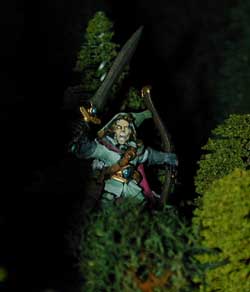
These are Tree Cults, who specialise in using the Magic of the Trees. The most prominent are the elite Elvish Tree Cults of Taur Galen:
Other known Tree Cults are:
A Tree Cultist Druid (or Tree Shaman) may favour a particular Totem Tree with which they have a special affinity. A list of possible Totem Trees from which to select is included as a drop-down list in the "Totem" field in the "Druidic Abilities" tab of the latest version of the Random Character Specification spreadsheet and the full list may be consulted in the "Totems" column to the right (below the Animals).
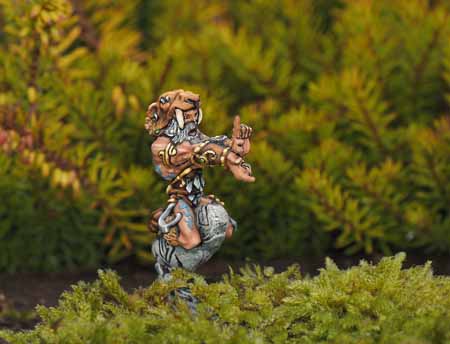
These are Animal Cults, who specialise in using the Magic of Animals. They may be general Beastmaster Cults, who use the Magic of all Animals (although individual Cultists or Tribes within the Cult will have a specific Totem Animal) or specific Beastmaster Cults dedicated to a single Totem Animal Species. The most prominent general Beastmaster Cults (or Cults which have Beastmaster elements or Spell Cycles) are:
The most prominent specific Beastmaster Cults are:
Other Cults or Tribes may have Shamen who specialise in the Magic of their particular Totem Animal.
A Beastmaster Druid (or Shaman) may be chosen by a particular Totem Animal with which they have a special affinity. A list of possible Totem Animals from which to select is included as a drop-down list in the "Totem" field in the "Druidic Abilities" tab of the latest version of the Random Character Specification spreadsheet and the full list may be consulted in the "Totems" column to the right.
The Seekers of the Lost were a enigmatic, spiritual and most elitist Cult, who sought enlightenment in some of the deepest mysteries of the North West Forest; the Trance of the Trees, the Will o' Wisps and THE WALKER IN THE FOREST. It is said they specialised in Mist and Mind Magic. They were revered for their ability to recover those lost to the Trance. They are believed to have all gone completely insane during the time of the Dark Forest in the Winter of 2501-2 , when they became Anti-Druids, and the Cult was wiped out. It was subsequently slowly rebuilt with the help of the AldaliŽ of the Calaquendi.
The Sandwalkers are Druids of the Deserts, who instress and are said to gain their media from the shifting sands and have a mystical side concerned with Desert Madness. They include Shamen of the Rat, Snake and Scorpion Cults, and are rumoured to be able to ride the Giant Sandworms of the Deep Desert.
The Readers of the Pattern are Druids of the Icelands, who instress and may gain their media from the patterns of ice crystals. They are one of the more mystical Cults. They include Shamen who are Auroch, Bear, Mammoth, Owl, Raven, Sabre-Toothed Tiger or Wolf Cultists.
The Dolphin Riders are the Druids of the Camari, who specialise in using the magic of Fish. They all have Faith in LLYWELLA and are the priesthood who support Her bid for Clerical status, pending which She grants their Spells using a custom Druidic system (which is rumoured to include a Druidic credit system).
These are Dwarvish Druids of the Khaz‚d-Valga, who instress and gain their media from Organisms. In the tongue of the Dwarves they are known as the Keragund. They use the magic of Oreads, and are said to be able to operate underground.
Most Druids do not believe such things as Anti-Druids exist. The first to come to the notice of Overworld Druids were those Druids of the North West Forest who were driven Insane by the coming of the Dark Forest, but certain Druidic Cults of the Underworld and the Deep Desert have practised the Dark Arts of Anti-Druidism for many years.
Go to Druidic Spell Lists (which include links to Spell Specifications)
Back to top of document
Back to MU System index
Back to Systems index
© P.R. Wild, 1979, 1999, 2024 / Minifig painting and photographs © A.R. Magnay, 2024
3rd Edition, v3.1 27 November 2024, last updated 16 August 2025